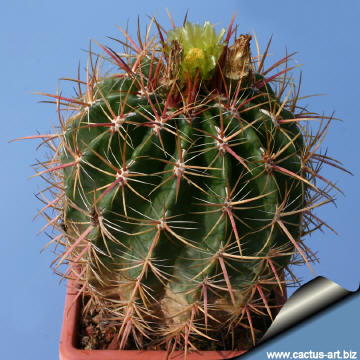|
|
|

Sometimes referred to as F. orcuttii , this barrel cactus
blooms when still of relatively small size.
|
 |
 |
|
|
|
 |
 |
|
Flower is usually yellow or yellowish-greenish and is 4cm in diameter. |
 |
 |
|
Propagation:
Seeds are the only way of
reproducing.
Seed
Collecting: Permit
fruit to
ripen.
Fruit must be significantly
overripe before harvesting seed; clean and dry seeds.
|
|


Advertising
|
|
|
|
|
Family:
Cactaceae (Cactus
Family)
Scientific name: Ferocactus
viridiscesns (Torrey
& A. Gray) Britton & Rose var. viridescens
Common Name: San Diego
Barrel Cactus
Synonyms:
- Echinocactus viridiscens
- Echinocactus orcutti Britton
et Rose 1913
- Ferocactus
orcuttii
- Ferocactus viridescens var. orcuttii
Origin: USA, (Southern
California in the Coastal San Diego County), Mexico (northern Baja
California)
Habitat: It can be found in rocky
coastal bluffs, coastal chaparral; shrub hillsides 0-200 m; often at the
crest of slopes and growing in cobbles. It occasionally is found on the
periphery of vernal pools, sometimes in considerable numbers. This
presumably more mesic habitat is unlike the very xeric situations where
it is typically found. This barrel cactus utilizes a number of other
soil types such as rocky silt loams and Redding gravelly loams.
Conservation status: Listed in
CITES appendix 2.
The 'viridescens' variety
has 13-25 tuberculate ribs and 15-25 spines per areole.
The 'littoralis' variety has 21-34 ribs that aren't tuberculate.
It has 21-34 spines per areole. It is indigenous only along the west
coast of Baja california down to Mission Santo Domingo.
Taxonomic notes: Ferocactus
viridescens var. viridescens stems are much shorter than those
of F. cylindraceus but the taxonomic distinctions between the two
species are muddled. In California, Ferocactus viridescens and F. cylindraceus are
allopatric. In the absence of geographic data, the largest plants of
F. viridescens might not always be distinguishable from straight-spined
mature plants of F. cylindraceus. Immature plants of F. cylindraceus
have mostly or entirely hooked spines but gradually switch to producing
straighter spines in old age.
|
|
Description:
Solitary, sometimes wider than tall.
Stems: Pale green Erect, oblate to spheric (to short cylindric),
usually 10-30(-45)cm tall × 10-20(-35) cm in diameter;
Ribs: 13-21[-34], 2 cm tall shallowly notched immediately above
each areole.
Areoles: Oval 10x 15mm with brownish tomentum.
Spines: 10-19 per areole, central spines and larger radial spines
pink or yellowish, turning grey as they age, smallest spines per areole
slender, sometimes bristle-like, less than 1 mm diam. (rarely absent);
central spines 4 per areole, the lower one stronger, straight or
slightly curved, annulate, thin and flattened, narrowly elliptic in
cross section, principal central spine 30-50 × 2-3(-5) mm. As
younger plant does have colourful spines.
Flowers: Infundibuliform 2.5-5 × 3-6 cm, colour similar inside and
out; inner tepals greenish yellow, sometimes with reddish brown
midstripes; stigma lobes yellow.
Fruits: Dehiscent through basal pore, bright yellow (very rarely
reddish), 20-35 × 15-25 mm, leathery or fleshy
Blooming season: pring-early summer.
|
|
|
|
 |
|
Cultivation:
They are summer-growing and pretty easy plants thought
slow to start. They are suited for any rich, well
drained soil such us clay, pumice, lava grit, and only a little
peat or leaf-mould. If potted, repot them preferably in the spring, if their
roots become cramped. Generally, they should be repotted every
other year in order to provide fresh soil. However, this doesn't
necessarily mean they'll need larger containers. Fill about a quarter of
the pot with broken crocks, gravel, etc. to promote good drainage. After
repotting, do not water for a week or more. Water regularly during the
aestival growth cycle (this plant need plenty of water, but do not
overwater and let their soil dry out between waterings),
and also needs to be avoided wetting the body
of this plant while it is in sunlight. A wet cactus in the sun light can
cause sun burning which can lead to scares or even fungal infections and
death, keep rather dry in winter. No water should ever be allowed to
stand around the roots. Feed with a high potassium fertilizer in summer.
Exposure: Outside they need a bright exposure,
full sun or half shade in summer if the location is exceedingly hot or
bright, inside needs bright light, and some direct sun.
It can tolerate moderate shade, and a plant that has been growing in
shade should be slowly hardened off before placing it in full sun as the
plant will be severely scorched if moved too suddenly from shade into
sun.
Frost Tolerance: Light frost protection required for
safe cultivation, but can tolerate sporadic light frost. This
plants need a period of cool rest in winter to produce flowers
abundantly.
Diseases and pests:
Watch for infestations of
mealybug, scale insects and spider mite.
Plant in good conditions will
start to bloom when reach the diameter of only 12-14 cm.
|
|